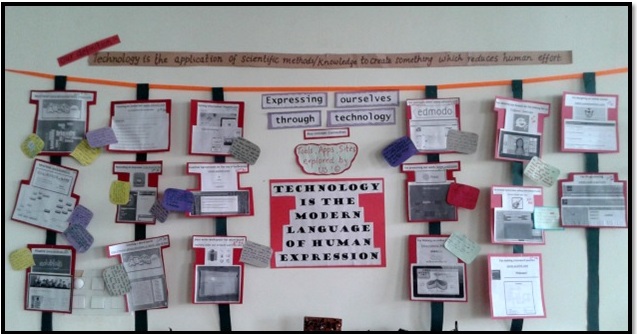This blog post talks about exploring different forms of technology as part of the trans-disciplinary theme How we express ourselves.
During a unit under the transdisciplinary theme How we express ourselves, we explored how technology can be a modern language of human expression. We began working around the tool or app of the day to assist the students in moving further in their inquiry process.
Students learned to install educational apps on the iPad and then use to gain understanding on the different forms of technology. Everyday’s tool went up on the “tool-wall” with a review from a child – describing how it is used and what are the advantages and the flaws of that particular tool. Over the next 5 weeks, we explored and used around 22 new apps and our “tool-wall” became a real asset to the class (and to the school)!
One of our learning engagements was to create a tool to teach various concepts of fractions through using ”educreations” and “show me” apps to students in Year 4. They met with their friends in Year 4 and asked them what about fractions they find most difficult to understand. Their list included the concepts of number line, simplification, addition of mixed fractions and equivalence.
Year 5 students began thinking about simplifying these concepts for the Year 4 students. They realized, of course, that it is not as simple as it appears! They need to use manipulative in order to make it interesting for their audience otherwise they would lose interest; they need to have a script ready before they record because they cannot pause in between; they need to be audible and their voice needs to be crystal clear; their hand writing has to be legible; and they cannot go too fast with either writing or speaking, and both need to be in sync.
 Once students had this check-list to guide everyone, the real work began! It was a pleasure to see the students trying to break down their instructions for more clarity; taking several pictures, from various angles, before choosing one for the final piece; convincing each other about the method; cooperating with great ease and taking turns to give voice-overs for different part of the tutorial; delegating work depending upon better handwriting, clearer voice and ease with the tool; troubleshooting without any fuss; finding a quieter place for recording; and, celebrating after recording their last words: “Thank you for watching this tutorial. We hope you will never go wrong with this concept again!”
Once students had this check-list to guide everyone, the real work began! It was a pleasure to see the students trying to break down their instructions for more clarity; taking several pictures, from various angles, before choosing one for the final piece; convincing each other about the method; cooperating with great ease and taking turns to give voice-overs for different part of the tutorial; delegating work depending upon better handwriting, clearer voice and ease with the tool; troubleshooting without any fuss; finding a quieter place for recording; and, celebrating after recording their last words: “Thank you for watching this tutorial. We hope you will never go wrong with this concept again!”
These tutorials were shared with the Year 4 students who actually gave feedback to their friends about their creation. As a facilitator, I watched them taking control of the tool to create something which could help many students in the time to come.
This unit of inquiry has provided the students with the opportunity to develop the following attributes of the IB learner profile, attitudes and skills: curiosity, cooperation, tolerance, respect, risk-taking, communication, thinking and self-management skills!
—
Vandana has been a primary educator for the last 11 years in international schools from New Delhi to Tokyo and believes in good pedagogical practices and keeping her children happy and excited about every single moment of the day.


